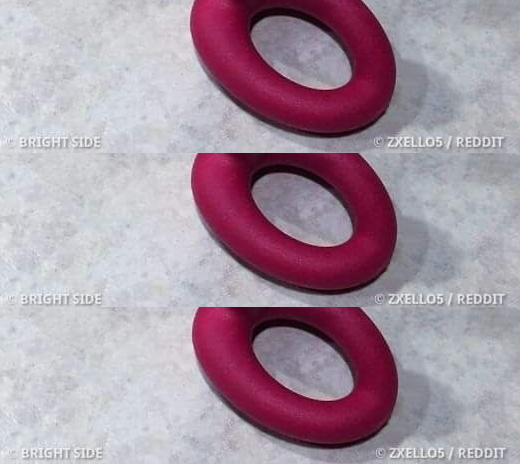Every so often, the internet stumbles upon a true mystery—a strange object that defies logic. Someone posts a photo online, asking, “What is this?” And within minutes, a wave of curious minds, collectors, and veteran Reddit detectives swoop in. From peculiar antiques to forgotten household gadgets, the web has become the world’s largest detective club for lost and puzzling objects.
Here are sixteen of the most fascinating discoveries—each a small riddle solved by the collective knowledge of the internet.
One user shared a satin-padded item with ribbon ties and a hole in the center. “Looks handmade,” they wrote, “maybe for a beauty product?” Turns out, it wasn’t for makeup at all. It was a clothes hanger cover, meant to protect delicate garments like silk slips or lingerie from slipping off. The ribbons tie around the hanger, while the satin padding prevents snags—a simple, elegant relic from vintage closets.
Another found a small metal spring device holding two red glass balls. “Tiny tongs?” they guessed. In fact, it was an old-fashioned razor sharpener. The red balls were handles, and the mechanism used friction to restore dull blades in the era of reusable razors.
Someone posted photos of glass discs engraved with flowers, each weighing around 600 grams. Many guessed “decorative coasters” or “candle holders,” but they were actually antique furniture casters, placed under piano or table legs to protect wooden floors.
A father asked, “My son found this in the kitchen. My wife doesn’t know either.” The object? A measuring cup holder designed to keep small cups neatly stacked in a drawer—a kitchen mystery solved with a touch of nostalgia.
A photo showed a strange metal frame bolted above a child’s bunk bed. “Safety rail?” someone guessed. It was actually part of a Buzz Lightyear-themed bunk bed set, meant to hold a canopy that turned the bed into a tiny space capsule.
One woman discovered tiny brown pellets under her husband’s pillow and feared insects or droppings. The answer? Foam from the mattress had started to break down and ball up, escaping through the cover. Panic avoided.
A puzzling 16-inch chain holding glass spheres “the size of small fists,” weighing nearly 40 pounds, had people guessing garden décor or a chandelier. It was actually a rain chain, guiding water from gutters to the ground while creating a soothing trickle.
A ceramic bowl with a hole at the bottom stumped someone until it was revealed as a flower bulb forcer, used to grow bulbs like hyacinths indoors without the bulb sitting in water.
A jewelry box contained a small disc on a chain. Decorative, yes—but also part of an antique lady’s watch chain, designed to clip to clothing so a pocket watch stayed within reach.
One homeowner worried about a “camera-like device” pointing at their backyard. It turned out to be an ultrasonic animal deterrent, keeping stray cats and dogs away with a sound humans can’t hear.
A hinged gold locket with a mirror and spinning wheel was identified as a vintage powder compact, used by women to store face powder and apply it with a puff before portable makeup kits existed.
A gold-plated clip with a horse emblem and a short cord? An early Beltone hearing aid—the clip held a microphone that connected to a pocket amplifier, a glimpse at how hearing technology has evolved.
A dorm student photographed a narrow wall alcove, guessing at its purpose. It was a mini phone booth from 1969, where each floor had a shared landline, allowing students to make calls home or to distant boyfriends.
Someone found a small metal “rocket” on three legs. It was a mid-century bar tool stand, holding shakers, openers, and stirrers—a retro, space-age style.
A hiker discovered a five-foot-tall brick pillar in the woods. Locals revealed it was a boundary post, once holding a plaque marking the entrance to a housing district. Time erased the sign, but the structure endured.
Finally, a tennis racket attached to a chain with a ball at the end? It was a net-measuring tool: hook it over a tennis net, and when the ball touches the ground, the net is at regulation height.
These small mysteries remind us how easily everyday objects can fade into obscurity. The internet turns curiosity into collaboration—a person in Ohio helping a stranger in Sweden identify a 1950s kitchen gadget, a retired carpenter solving a puzzle that stumped thousands.
Even more, these discoveries bridge generations. Grandmothers recognize hair accessories from the ’60s, collectors identify Victorian tools, and younger people learn how utility and artistry once blended seamlessly. Forgotten objects become miniature time capsules, revealing how people lived, worked, and invented before the digital age.
In a world where we often discard items the moment they break, these curiosities remind us of durability and ingenuity. That “weird metal thing” might be a century-old tool for sharpening razors. That “random piece of glass” might have once protected a parlor floor under a piano.
Next time you stumble upon an unidentifiable object—an attic contraption, a mysterious heirloom, or a quirky thrift-store find—don’t toss it. Post it online. Somewhere, someone knows its story.
Because one person’s junk can be another’s mystery—and discovering what it is can teach us even more about who we were.
